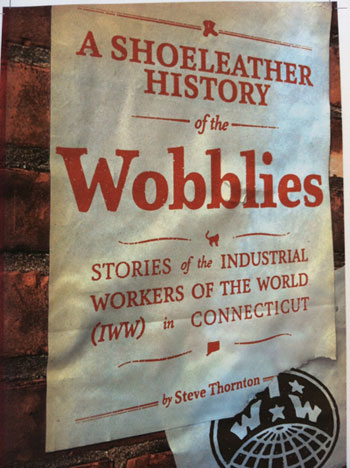
Generally speaking, grassroots labor movements, the Wobblies in particular, don’t receive histories on a state-by-state basis. Surely, if a state labor council exerted a notable influence over policy and politics, that well might be worthy of a study. But the Wobblies in Connecticut? Is that a subject? Are the resources for such a book even still extant?
We think back on the anarcho-syndicalist IWW, founded in 1905, and conjure up images of woodworkers, dockworkers, itinerant farm workers, and of course the great textile mill strikes in Lawrence, Mass., and Paterson, N.J., in the early 20th century.
But Steve Thornton is a longtime union organizer (SEIU), and before that ILGWU (now UNITE HERE) and AFSCME, who served on the Greater Hartford Labor Council.
He also threw himself into anti-war campaigns, housing rights activism, and radical journalism. So if there was anyone who would conceive to write such a book, Steve is your man. And in fact, he’s given us “A Shoeleather History of the Wobblies: Stories of the Industrial Workers of the World (IWW) in Connecticut.”
A hundred years ago, Hartford, Bridgeport, Bristol, Waterbury, New London, Willimantic, New Haven, Shelton, Ansonia, and other Connecticut towns had thousands of workers, many of them immigrants, employed in foundries, textile plants, furniture manufacturing, arms plants such as Colt and Winchester, and other industries. In an era
of widespread labor abuses – exploitation of children, unpaid wages, long working days, no overtime, no compensation for sickness or injury, docking pay for minor offenses or for situations beyond the worker’s control (such as looms that often broke down), denial of the right to organize, or even to free speech – the IWW was around to “fan the flames of discontent,” as its famous little red songbook liked to claim.
Connecticut was not immune to all those issues. Thornton brings in a rambunctious, rowdy, defiant cast of characters from those years, people who either passed through on speaking or organizing tours, or who became local, home-grown radicals. Figures such as Elizabeth Gurley Flynn, Carlo Tresca, Big Bill Haywood, Ben Legere, Robert Rives La Monte, Arturo Giovannitti, Emma Goldman, Helen Keller, Eugene V. Debs, Joe Ettor, Lucy Parsons, and Matilda Rabinowitz (later Robbins), make dramatic entrances and exits through Thornton’s pages, giving rousing speeches in theaters or union halls, and often chased out of town by vigilante sheriffs after a good thrashing or jail sentence.
Thornton does a good job at threading us through the byways of long-gone political movements, showing how the Socialist Party was at first a strong ally of the IWW, then backed away from it, and also how the SP and the Socialist Labor Party under Daniel De Leon split from one another. For a long time, the AFL, the federation of traditional craft unions, was hostile to the idea of “One Big Union” that the IWW promoted, often opposing the Wobblies’ embrace of the foreign-born, non-English speakers, women workers, and people of color. (In the 1930s the CIO took up this more expansive, inclusive vision.)
The IWW is famous for its free speech fights, especially ironic in Connecticut, nicknamed the “Constitution State.” Especially at the time of World War I and the subsequent Palmer Raids on anarchists, Bolsheviks, and perceived radicals of every stripe, they played an important role in alerting otherwise average citizens to the real absence of constitutional norms in our country.
Thornton reminds us that those ubiquitous buildings found in most major cities, the local state armories, came into being precisely at this time, as a home for the National Guard or state home guard. Each one of these was a “fortress specially created and built to defend against homegrown unrest” (p. 88).
“Wobblies in Connecticut” draws on published memoirs, the work of labor historians, and ample use of local newspaper archives, even Helen Keller’s FBI file, and is dotted throughout with evocative period graphics and photos.
As expected, this story is not a neat narrative with a clear beginning, middle, and end. It jumps around a bit, as did the industries and personalities and the workers themselves. A complicated, inconsistently documented history cannot be told in a simple way. Sources are provided, but they’re sometimes sketchy and out of order.
Nevertheless, of such modest building blocks our history is made. The struggle continues, and as we know, often doesn’t look very different than a century ago!
See ShoeleatherHistoryProject.com for more grassroots stories.
Book information:
“A Shoeleather History of the Wobblies: Stories of the Industrial Workers of the World (IWW) in Connecticut”
By Steve Thornton
2013, Red Sun Press, 150 pages, $11.99








